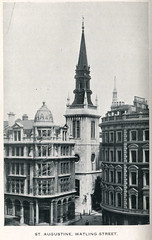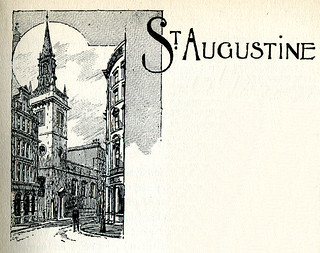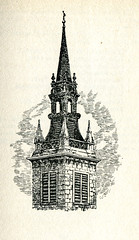| |
|
|
|
|
Until the Second World War, St Paul's Cathedral
was hemmed in by narrow, busy streets, a working
modern city on a medieval plan. These streets
were home to dozens of little churches, their
turrets, spires and finials, by the genius of
Wren and his collaborators, working as a tribute
and foil to the great bulk of the cathedral
overshadowing them. The first picture below gives
an idea of the setting of St Augustine at this
time. The church was a medieval foundation of the
12th Century, destroyed in the Great Fire and
rebuilt by Wren in the 1680s. The tower finial
appears to have been Hawksmoor's design. No
church was closer to the rebuilt St Paul's, and
although the Cathedral withstood the German bombs
of 1940 and 1941, its little neighbour did not.
Only the tower survived, restored by Seely &
Paget in 1966 (the curent finial is theirs) and
incorporated into Leo de Syllas's
uncompromisingly modernist building for the
Cathedral Choir School in 1968. It all works
rather well.
St Augustine got its dedication because it stands
at the London end of Watling Street, the road
from Canterbury. Travellers and returning
pilgrims could stop here on first entering the
City to give thanks to Canterbury's own saint for
their safe journey. Although rebuilt, it is still
possible to walk westwards up the line of Watling
Street and see the safe haven of the church's
spire ahead of you, the great cathedral beyond. |
|
|
|
|
|
|
|
|
|
|
|
|
|
Simon Knott, December 2015
location: Watling Street EC4M 8AD - 1/011
status: tower only - part of school
access: visible from road
   
Commission
from Amazon.co.uk supports the running of this site
|
|
|
|
|
|
